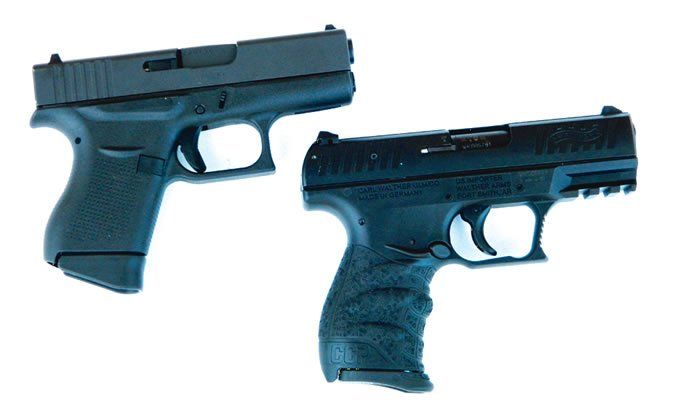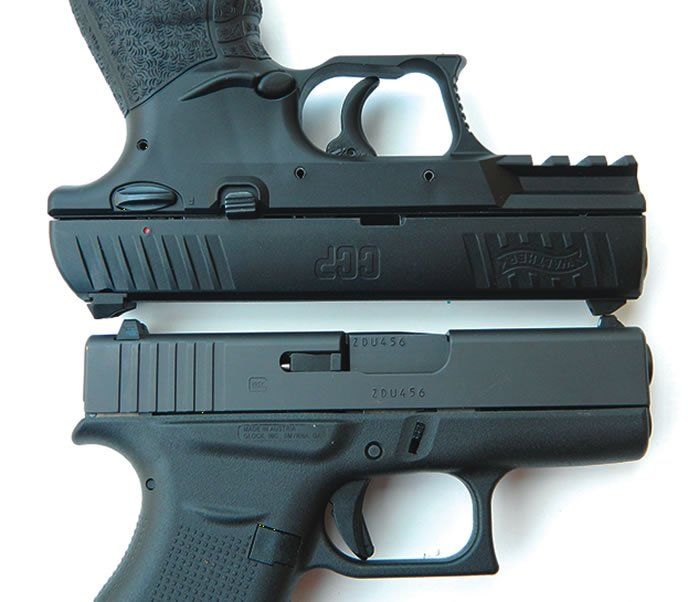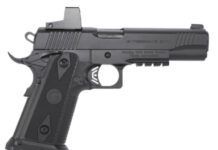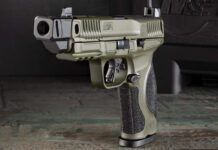The compact 9mm pistol market is hot, and two of the newer additions to the marketplace are the Glock 43 Subcompact Slimline G43 PI4350201, $499, and the Walther Concealed Carry Pistol CCP 5080300, $452. The Glock is a long-awaited single-stack version of the other Glock pistols, but we found the G43 to be a re-engineered pistol that isn’t simply a single-stack Glock 26. The frame design is a good one for personal defense if you need a pistol this size. The Walther CCP is a bit larger, so it holds two more cartridges and proved more accurate. The Walther also featured a light rail. So, in our view, we had two pistols that fit the same niche for concealed carry, but we wondered how the size and capacity issues would strike our testers.

We should mention that the raters for this test were a good mix in age and experience, from early twenties to early sixties. Among the shooters involved in this test were one with more than 40 years of shooting experience, and another has operated a respected gunsmith operation for 30 years. A third was a military intelligence officer; a fourth was a 50-ish female who carries daily, and the fifth was a college-age female who is an NRA-certified instructor.

During the firing test, both pistols were carried in a Barber Chameleon holster ($29.95, postage included, from BarberLeatherWorks.com) This affordable holster is well made of quality leather, and it offers a belt loop for use as a belt slide. There is a strong steel clip for inside-the-waistband carry. We used the holster as a belt slide for both pistols during this test.
What we didn’t anticipate was the Walther getting the lion’s share of attention — but not for good reasons. Because the pistol did not work to our satisfaction, we explored its operating system in depth, attempting to find remedies that we could disclose to readers who might prefer the CCP for one reason or another. Here’s what we found:
Walther Concealed Carry Pistol CCP 5080300 9mm Luger, $452
This price was from TombstoneTactical.com at the time of our test. The first impression of the Walther CCP was that the pistol is slightly larger than the Glock 43, perhaps in SIG P225 territory, although lighter. If you presently carry a Glock 19, either pistol is smaller and lighter. This isn’t a bad place to be. The CCP pistol was slightly larger and heavier than the G43, as our measurements confirmed. However, the CCP wasn’t a large handgun by any means, at just 6.4 inches long and 1.18 inches wide.
The pistol was supplied with two 8-round magazines. The magazines were steel units with the body crimped in place rather than welded, as many magazines are. We like that. The 8-round magazine versus the Glock’s 6-round magazine gives the CCP a two-cartridge advantage over the Glock 43, but there’s a trade off, and as the comparison continued, we realized this more and more. You might choose the Glock 43 9mm over the Glock 42 380 ACP, because the former offers more power for just a slight increase in size. The Walther might be chosen over the Walther PPS because it shoots better, and the same relationship exists when compared to the Glock 43. The Walther is just enough larger than the G43 that the CCP has more gripping surface and less muzzle flip. On the other hand, it is just enough larger that you may choose the Glock 43 9mm for concealed carry.
The CCP’s slide was interesting. While about the same width as the Glock 43, the Walther’s top flat was narrower, and the slide tapered toward the frame differently. The ejection port was smaller than the Glock. While we never had a fumble during administrative handling or firing, the CCP’s smaller slide seemed less modern. The CCP featured well-defined cocking grooves, with a total of 28 grooves, seven forward and seven to the rear on each side of the slide. Forward cocking serrations are seldom seen in a handgun this size, but these came off well. The slide was monolithic, with no cut out in the front for a recoil guide, as the recoil spring is wrapped around the barrel rather than under the barrel.
We preferred the CCP’s sight picture compared to the Glock, in part because the Walther’s rear sight was more open than the Glock. The three white dots set in black iron sights gave a good sight picture all our raters felt was superior to the Glock’s typical white-outline rear and white-dot front sight. The CCP was supplied with two extra front posts, so they may be changed for use with diverse 9mm loads to change the point of aim and bring it into line with the point of impact. Because 9mm defense ammunition may range in weight from 92 to 147 grains, the ability to change the front-sight height is a plus, in our view. The rear sight may be adjusted for windage with a supplied tool, but lateral play on the slide was limited, with no advantage over the Glock in this regard.
The CCP had a polymer frame like the Glock, but the CCP featured a light rail for mounting a combat light or laser. We rated this a superior feature. While few may carry a compact 9mm with a combat light attached or even on the body, home defense is another matter. After carrying the CCP concealed during the day without the light attached, it was a simple matter to lock a Viridian combat light into place for home defense. We also preferred the Walther’s grip texture and feel better than the Glock’s. The front of the trigger guard was serrated and supplied more abrasion than the Glock, for shooters who like that hold. The top of the frame was smooth where it should be. The grip frame was nicely roughened with an aggressive pattern and three finger indentations, which gave excellent purchase when firing the pistol.
The magazine release was protected by a small shelf molded into the frame. There were no issues with this part; it functioned as it should. The pistol also featured a frame-mounted safety. Some users like a manual safety, others will ignore it. Some feel that the absence of a safety abrogates some of the advantages of a self-loading pistol, although they seem to be the minority. The safety gives users an option.
Another feature superior to the Glock 43, we felt, was the CCP’s trigger action. The Walther trigger broke at a smooth 5 pounds. There was considerable take up; however, the trigger action was very fast once the shooter managed a short acclimation period. For safety, a self-loading pistol must have take up and reset in the trigger action. The Walther CCP featured among the cleanest trigger breaks of any polymer-frame striker-fired pistol we have tested, once the slack in the trigger was taken up. This trigger action, along with the good sights, explains the superior performance of the Walther in accuracy tests.
The Walther’s lock up was much different than the Glock. The CCP isn’t a locked-breech pistol, breaking convention in polymer-frame compact pistols. The CCP is a blowback design with a fixed barrel. The fixed barrel is another advantage in accuracy. The only way to make blowback operation work in such a handgun is to use a massive slide or some type of gas operation. Toward this end, the Walther borrows a chapter from the Heckler & Koch P7M8 pistol. The Walther SoftCoil design uses a vent in the barrel to direct gas to a mechanism beneath the barrel. This gas is directed to a piston inside a chamber that acts to slow down the recoil of the slide. Once the bullet has exited the barrel and pressure has subsided, the pressure from the chamber relents and allows the slide to recoil to the rear. This gas cylinder doesn’t kick the bolt, as in the case of the AR-15, but rather inhibits slide movement. Walther makes claims that this system reduces muzzle flip and recoil. We’re willing to grant that it may play a part in making the pistol easier to shoot well, but the larger grip and heavier weight of the CCP versus the Glock are bigger advantages, in our estimation. The system also allows easier cocking of the slide, according to Walther, because the recoil spring need not be as heavy. Most of the raters could not detect a real difference. However, one of the raters, a 50-ish female, noted that the CCP was indeed easier to rack to load. Even so, she had no problem with the Glock 43. All in, a combination of forward cocking serrations and the SoftCoil system will matter most to those who really need it. The Walther is easier to rack, load, and unload than most compact 9mm pistols, including the Glock 43. We simply did not find the difference to be profound.
To begin the process, we field-stripped and examined the CCP before firing it. We noticed the slide was well machined and finished, and the polymer frame showed quality manufacture, with no intrusive seams or stray pieces of plastic. There were no slide rails. There were metal inserts in the frame, but no true rails. To field-strip the CCP, you must manipulate a lock on the rear of the slide. This plug is depressed to clear a hook on the CCP frame to allow the slide to be removed. A tool is supplied with the pistol that is designed to be used to press on the locking tab while the tab is unlocked, allowing the slide to be removed. The supplied tool did not work despite our best efforts. We used a screwdriver. Our team noted that they hoped the pistol would not need to be cleaned often.
When reassembling the pistol, the slide did not easily go back into place. One rater became frustrated and handed the pistol to another shooter, who saw the pin or tab was not allowing the slide to close. The assembly had turned in its tunnel, and as the slide finally snapped home, the lock and tab were ejected by the striker spring. This is part of the procedure for cleaning the striker, but we were not intending to dissemble the pistol at that time. Rather than take a chance on damaging the handgun, we took the gun to the gunsmith on our team for reassembly. This rater got the gun back together. We spent some time with experienced individuals on discussing the takedown. A simpler design, such as the HK P7M8 plunger, would have been preferred.
The takedown may be a deal breaker for some, to others it is simply something different, but we did not like the design. If Walther were going to borrow so much from the HK P7M8, perhaps they should have borrowed a bit more and used a straightforward HK-type break down. In the HK’s case, the gas piston will need to be scrubbed free of carbon deposits from time to time, depending upon how dirty the powder is and how often the pistol is fired. Judging from the HK P7M8 we’ve owned in the past, this means perhaps every 1,000 rounds for best function. Walther could have executed the CCP better, in our view, because the field-strip was a glaring misstep compared to the Glock.

During the firing tests, we used two loads during the familiarization stage and three loads for accuracy. Initial firing was accomplished with the HPR 115-grain FMJs, an affordable loading well suited to breaking in a new firearm. We also used a smaller quantity of Winchester 147-grain Defend loads. The Walther proved reliable at the start, with no failures to feed, chamber, fire, or eject with 100 rounds of the 115-grain FMJs. The pistol was pleasant to fire. Fired offhand at humanoid silhouette targets at 5, 7, and 10 yards, the pistol gave excellent results for a handgun in this size and weight category. Combat reloads during combat shooting also went well. We wished we had more magazines on hand, as the crew enjoyed firing this pistol, only stopping to load magazines. It was clear to our shooters that the Walther was more pleasant to fire than the Glock.
However, when we began firing Winchester Defend 147-grain JHPs, we suffered four failures to fully go into battery, with much of the cartridge case exposed, before we could complete a box of 25. Was this a break-in malfunction? The pistol had fired hundreds of the 115-grain loads without problem.
In accuracy testing, we used three loads. The Cor-Bon 95-grain DPX is a superior defense load using a solid-copper Barnes bullet. With this round, we found recoil was the heaviest of any load tested. Even so, the recoil wasn’t prohibitive from a load clocking faster than 1350 fps from a 3.5-inch barrel. With the DPX, the HPR 124-grain JHPs, and Hornady’s 115-grain Critical Defense FTX hollowpoints at 15 yards, we noticed the CCP required attention to detail to produce good accuracy due to the short sight radius and light weight. Accuracy for five-shot groups ranged from a smallest group of 1.6 inches to a largest group of 2.6 inches. As far as personal-defense accuracy at this range, we thought the pistol performed well. However, the pistol failed to cycle with the Cor-Bon load on three occasions and failed to extract that round twice. The Glock functioned normally with everything.
We didn’t fail the CCP for these malfunctions because of our experience with the similar Heckler & Koch P7M8, which in the hands of one of our testers has been perfectly reliable for more than a decade with 115- and 124-grain standard-pressure loads. But the P7M8 will not function with the Glaser Safety Slug at all, and +P loads are not recommended in it. Also, 90-grain JHP loads will not function, and neither will subsonic loads. Otherwise, the pistol has fired at least 5,000 trouble-free rounds with standard-pressure loads using 115- and 124-grain bullets. So, we simply say the Walther was finicky about the loads it liked, whereas the Glock wasn’t — a big edge for the Austrian.
Our Team Said: The Walther CCP was accurate, handled well, featured a manual safety and a light rail, and offered two more rounds of magazine capacity. It was larger and heavier than the Glock, so it is better suited to holster carry than as a pocket handgun. But even with its positives, the malfunctions during the combat firing stage and during the accuracy stage made us doubt its reliability with the full range of defensive ammunition available today. Also, its takedown process earned it a demerit. Whether our final rating was a C or a D doesn’t really matter to us. Based on our experience with it, we wouldn’t buy the CCP.
Glock 43 Subcompact Slimline G43 PI4350201 9mm Luger, $499
The price as listed was from Slick Gunsat the time of our test. The Glock 43 is a long-awaited, perhaps even heralded, handgun. The pistol will appeal to Glock fans, but also, perhaps for the first time, to concealed-carry handgunners interested in a pistol in the Kel-Tec/Smith & Wesson Shield size. At Gun Tests, each pistol must stand on its own merits, but comparisons are inevitable. We think the Glock 43 comes off better than the Glock 36 Slimline 45 and the mini Glocks in many particulars.

To begin at the top, the slide was narrow and nicely beveled. Glock did not simply stick a Glock 19 slide on a slim frame. The locked-breech operating system and trigger action are preserved. Anyone owning a Glock of any size or frame will be able to use this handgun in the same manner because the action is identical to all other Glock pistols. The locked-breech action keeps the slide and barrel locked together in recoil until the pressure of firing abates as the bullet exits the barrel. When the Glock slide is racked, it partially preps the action. Next, the trigger is pressed to move the striker to the rear, finally breaking the striker against the striker spring, firing the pistol. The small lever set in the trigger is a safety against trigger movement if the pistol is dropped and also against lateral discharge.
As mentioned above, the sights were standard Glock, with a white outline rear and white dot forward. They proved adequate for combat firing and reasonably good for accuracy work at 15 yards. In common with the Walther, the sights were properly regulated for 115-grain loads at 15 yards. The Glock did not come with additional front-sight posts. The pistol fired low with the 95-grain loads tested, but slightly high with 124-grain loads. This may be accounted for in combat shooting, but considerable practice should be expended in doing so.
There is a shelf under the slide on the frame that protects the slide lock from a finger contacting the slide lock during recoil. Here, Glock learned a lesson with the Glock 26 design, we feel. It is common for the support-hand thumb to bump the slide lock and lock the slide to the rear when firing a hard-kicking compact. The shelf seems to eliminate this problem, as it did not occur during the firing test. The slide was textured in a fashion that affords adequate purchase when firing. The Glock frame does not incorporate a light rail for a combat light. Since this is a concealed-carry piece, even a deep-cover piece, this isn’t a deal breaker, but it is a consideration.
We fired the Glock with the same mix of ammunition as the Walther: HPR 115-grain FMJs and Winchester’s 147-grain JHPs for familiarization. Then came accuracy testing from the bench with Cor-Bon DPX 95-grain loads, HPR 124-grain JHPs, and Hornady 115-grain FTX rounds, and combat-shooting drills, as well as an additional 50 rounds of HPR 115-grain FMJ loads for a final evaluation. The Glock never malfunctioned.

The Glock featured a spring-within-a-spring guide rod that we feel does an excellent job of containing recoil, so much so that our raters with the most extensive firing experience detected little difference in recoil until firing the Cor-Bon 95-grain DPX. At this level of recoil, muzzle flip was more noticeable with the Glock. However, the young female had no problem with the Glock . In combat-style shooting, the Glock and Walther were both fast to target, but the smaller Glock was faster from leather than the Walther. Once on target, however, the Glock was handicapped by the heaviest factory Glock trigger our South Carolina unit has tested. We checked Glock 19, 22, and 23 pistols and found most broke at 5.5 pounds. A Glock 41 in 45 ACP was 6.5 pounds. The little Glock 43 consistently broke at 6.75 pounds. In any case, the Walther fired better accuracy and combat groups than the Glock. If it is important to you, neither handgun is suited for lead-bullet handloads, the Glock due to its polygonal rifling and the Walther due to the possibility of clogging the gas port.
Our Team Said: The Glock 43 had what it takes to earn our respect: it was reliable, safe, and easy to maintain. But in many ways, it suffered in comparison to the CCP — less accurate, tough trigger, no light rail. This is a good 9mm carry gun, but its shortcomings put it a notch below an A, in our estimation.
Written and photographed by R.K. Campbell, using evaluations from Gun Tests team testers.



























